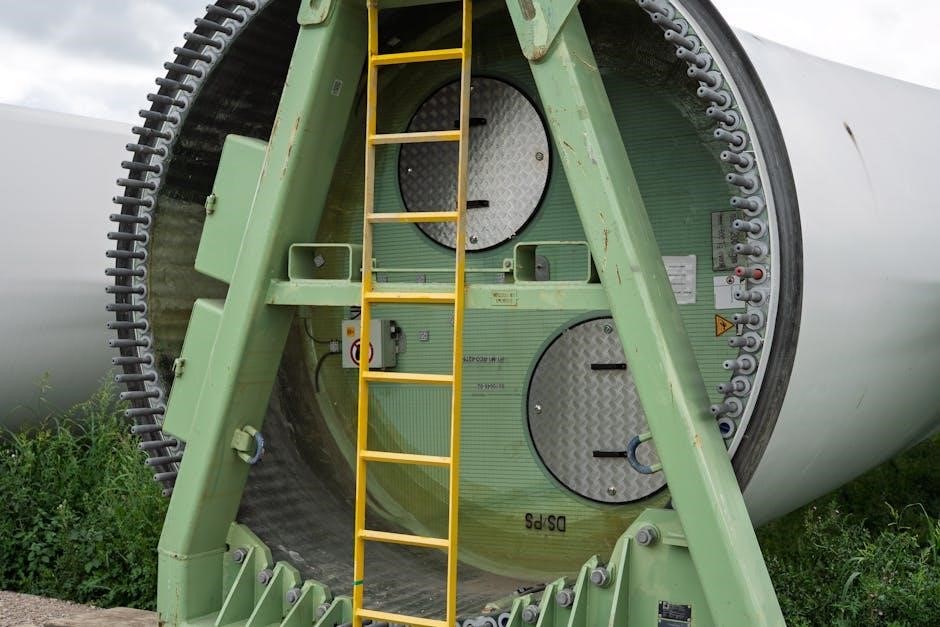The Honeywell TH3210D1004 is a non-programmable digital thermostat designed for 2 Heat/1 Cool heat pump systems, offering easy installation, compatibility with various HVAC setups, and energy efficiency.
1.1 Overview of the Thermostat
The Honeywell TH3210D1004 is a non-programmable digital thermostat designed for 2 Heat/1 Cool heat pump systems. It offers a straightforward interface for temperature control, ensuring ease of use and reliability. Compatible with 24 VAC systems or battery power, it provides flexible installation options. The thermostat features a clear digital display, allowing users to set and maintain desired temperatures efficiently. Its design focuses on energy efficiency and seamless integration with existing HVAC systems, making it a practical choice for homeowners seeking a durable and user-friendly temperature control solution. This thermostat is ideal for those who prefer simplicity without compromising on performance.
1.2 Compatibility with Heating and Cooling Systems
The Honeywell TH3210D1004 is specifically designed for 2 Heat/1 Cool heat pump systems, ensuring compatibility with various HVAC configurations. It supports systems requiring dual heating stages and single cooling, making it versatile for different home setups. The thermostat can be powered by 24 VAC or batteries, offering flexibility in installation. Its terminals accommodate connections for heating, cooling, and fan operations, ensuring seamless integration with existing systems. This compatibility allows homeowners to maintain consistent temperatures while optimizing energy efficiency, making it a reliable choice for heat pump systems.

1.3 Key Features and Benefits
The Honeywell TH3210D1004 offers advanced features like a digital display for precise temperature control and compatibility with both 24 VAC power and battery operation. Its non-programmable design ensures simplicity, while the dual heat and single cool functionality optimizes performance for heat pump systems. The thermostat also includes a built-in fan control, improving air circulation. Energy efficiency settings help reduce utility bills, and the compact design allows for easy installation in standard locations. These features make it a reliable and user-friendly option for maintaining a comfortable home environment with minimal complexity.

Pre-Installation Checklist
Verify system compatibility, gather tools, and ensure power is off. Check wiring labels, confirm thermostat location, and prepare materials for a smooth installation process.
2.1 Tools and Materials Needed
For installing the Honeywell TH3210D1004 thermostat, essential tools include a screwdriver, pliers, wire stripper, and voltage tester. Materials needed are new wires (if required), mounting screws, and possibly a wall anchor. Ensure compatibility with your HVAC system and verify the wiring configuration matches the thermostat’s terminal designations. Gather a ladder for reaching high installations and safety gear like gloves and goggles. Optional items include a level tool for accurate mounting and a marker for labeling wires. Having all materials ready ensures a smooth and efficient installation process without delays.
2.2 Understanding System Requirements
Before installing the Honeywell TH3210D1004 thermostat, ensure your HVAC system is compatible. It supports single-stage heating and cooling systems, including gas, oil, and electric configurations. Verify that your system operates on 24V AC power, as this thermostat is not compatible with line voltage systems. Check the number of heating and cooling stages your system requires, as this model supports up to 1 heat and 1 cool stage. Additionally, confirm that your system’s wiring matches the thermostat’s terminal designations. Understanding these requirements ensures proper functionality and avoids installation issues. Consult your HVAC system’s manual for specific details.
2.3 Safety Precautions
Before starting the installation of the Honeywell TH3210D1004 thermostat, ensure all safety precautions are followed. Always turn off the power to the HVAC system at the circuit breaker or fuse box. Verify the power is off using a voltage tester to avoid electrical shock. Be cautious when handling wires to prevent short circuits. Never overload the thermostat terminals, as this can cause damage or fire hazards. Wear protective gear, such as gloves and safety glasses, when working with electrical systems. Follow all local electrical codes and manufacturer instructions to ensure a safe and proper installation.

Wiring Diagram and Terminal Designations
The wiring diagram provides a clear visual guide for connecting the thermostat to your HVAC system, ensuring proper terminal connections for reliable operation.
3.1 Identifying the Wiring System
Before installing the Honeywell TH3210D1004, identify your HVAC system’s wiring configuration. Turn off power at the circuit breaker and remove the old thermostat. Inspect the wires to determine their lengths and connections. Note the terminal labels (R, C, Y, G, etc.) on your existing system. Verify if you have a common wire (C) or if a jumper is required. If unsure, consult the wiring diagram in the manual or online resources. Proper identification ensures correct connections and avoids damage. Take photos or label wires for reference during installation to simplify the process and minimize errors.
3.2 Connecting Wires to the Thermostat Terminals
After identifying the wiring system, connect the wires to the Honeywell TH3210D1004 terminals. Match each wire to its corresponding terminal (e.g., R to R, Y to Y) based on your system’s configuration. Strip the wire ends if necessary and insert them firmly into the terminals. Avoid forcing wires into incorrect terminals, as this may damage the thermostat. Use the wiring diagram in the manual as a reference. If you labeled the wires during removal, consult your notes for accuracy. Ensure all connections are secure and properly seated before proceeding. Double-check to avoid mismatches, which could cause system malfunctions.
3.3 Specific Terminal Designations (R, C, Y, G, O, B, Aux)
The Honeywell TH3210D1004 thermostat terminals are labeled as follows:
– R: 24V power from the heating/cooling system.
– C: Common wire, required for proper thermostat operation.
– Y: Cooling stage (usually connected to the compressor).
– G: Fan operation control.
– O: Heat pump reversing valve (if applicable).
– B: Optional, for heat pump auxiliary heat.
– Aux: Auxiliary heat (used for dual-fuel systems).
Ensure wires are connected to the correct terminals to match your system’s configuration. Refer to the wiring diagram in the manual for specific instructions. Proper connections are critical for system functionality and safety. If unsure, consult a licensed HVAC technician.

Installation Steps
Mount the thermostat, install batteries, and secure the wiring. Follow the step-by-step guide for proper installation, ensuring all connections are correct and safe.
4.1 Mounting the Thermostat
Begin by selecting a suitable location for the Honeywell TH3210D1004 thermostat, ensuring it is away from direct sunlight, drafts, and extreme temperatures. Typically, a wall in a central location of the room is ideal. Use the provided mounting bracket to attach the thermostat base to the wall. If necessary, use wall anchors to secure the screws firmly. Align the thermostat unit with the base and snap it into place. Ensure it is level and straight for accurate temperature readings. Mounting the thermostat correctly is crucial for proper functionality and energy efficiency.
4.2 Installing Batteries or Connecting to AC Power
To power the Honeywell TH3210D1004 thermostat, insert two fresh AA alkaline batteries into the battery compartment located on the back of the thermostat. Ensure the batteries are correctly oriented to match the polarity markings. If using AC power, connect the 24VAC power supply to the R (or 24VAC terminal) on the wiring harness. Do not use both batteries and AC power simultaneously. Turn off power at the circuit breaker before connecting any wires. Once powered, the thermostat will automatically turn on and display the home screen. Verify power by checking the display illumination and functionality.
4.3 Securing the Wiring
After connecting the wires to the thermostat terminals, ensure all connections are secure and tightly fastened. Use wire connectors or push-in terminals as specified. Avoid loose connections, as they can cause malfunctions. Gently tuck the wires into the wall or conduit to keep them organized and protected. If necessary, use wire clips or mounts to secure any excess wiring. Double-check that no wires are pinched or damaged during this process. Properly securing the wiring ensures reliable system operation and prevents potential damage or safety hazards. Turn the power back on at the circuit breaker only after all wires are safely secured.

Configuring the Thermostat
Configure the thermostat by setting up the installer menu, adjusting heating/cooling options, and customizing advanced features for optimal performance.
5.1 Setting Up the Installer Menu
Access the Installer Menu by pressing and holding the “Menu” button. Navigate through options like time/date settings, system type (gas furnace or heat pump), and fan settings. Refer to the manual for guidance. Configure settings according to your HVAC system and preferences. Ensure to understand each setting’s function before making changes. Save all configurations before exiting. If unsure, consult online resources or videos for visual assistance. Proceed step-by-step to avoid errors and ensure proper thermostat operation.
5.2 Configuring Heating and Cooling Options
After accessing the Installer Menu, configure heating and cooling options to match your HVAC system. Select the system type (e.g., heat pump or gas furnace) and choose the correct heating and cooling modes. Set the temperature range and differential for optimal performance. For heat pumps, configure auxiliary heat settings. Adjust the swing differential to balance temperature consistency and energy efficiency. Refer to the manual for specific settings based on your system. Save changes to ensure they take effect. If unsure, consult the user manual or online resources for clarification. Proper configuration ensures reliable operation of your heating and cooling system.
5.3 Adjusting Advanced Features
Access the advanced features menu to customize settings like geofencing, smart recovery, and temperature hold. Enable geofencing to adjust temperatures based on your location. Smart recovery learns your system’s operation to preheat or cool for consistent comfort; Use temperature hold to temporarily override schedules. Adjust humidity control if your system supports it. Set reminders for filter changes and maintenance. Enable energy-saving modes to optimize efficiency. Refer to the manual for detailed instructions on each feature. Adjust these settings carefully to maximize comfort and energy savings. Experiment with options to find the perfect balance for your home environment. Always save changes to ensure they take effect.

Testing the System
Activate the system to ensure heating, cooling, and fan operations work correctly. Verify temperature changes and proper cycling. Check for error messages or irregular behavior during testing.
6.1 Running a System Test
Start by switching the thermostat to both heating and cooling modes to ensure proper system response. Turn the system on and adjust the temperature settings to verify correct operation. Check if the HVAC system cycles on and off as expected. Monitor for any unusual noises or delays in response. Ensure the fan operates correctly in both auto and manual modes. Verify that the system maintains the set temperature consistently. If any issues arise, refer to the troubleshooting section or consult a professional for assistance. This test ensures the thermostat is functioning as intended and integrated with your HVAC system effectively.
6.2 Verifying Heating and Cooling Operation
To verify heating and cooling operation, set the thermostat to Heat mode and lower the temperature below the current room temperature. Ensure the heating system activates and warmth is produced. Repeat the process for Cool mode by raising the temperature above the current room temperature to check if the cooling system engages. Observe the vents for airflow and confirm the HVAC unit operates as expected. Monitor the system for consistent performance and proper cycling. Use the thermostat’s menu to verify temperature settings and adjustments. This step ensures both heating and cooling functions are working correctly and responding to thermostat commands effectively.
6.3 Checking Fan Operation
To check the fan operation, set the thermostat to Fan mode using the menu. Ensure the fan runs continuously and airflow is consistent from the vents. Verify the fan switches on and off correctly when toggled. Check for unusual noises or vibrations that may indicate issues. Use the thermostat’s display to confirm the fan is operational and responding to commands. If the fan does not run, inspect the wiring connections and ensure the HVAC system is powered on. Proper fan operation is essential for consistent heating and cooling distribution throughout the space.

Troubleshooting Common Issues
Address common issues like no heat/cool operation, fan malfunctions, or display problems by checking wiring, power sources, and system compatibility. Resetting the thermostat often resolves many problems.
7.1 No Heat or Cool Operation
If the system fails to heat or cool, first check the power supply and ensure the thermostat is properly connected. Verify wiring connections, especially the R, C, and Y terminals, for any looseness or damage. Confirm system compatibility with the thermostat and ensure the correct heating/cooling mode is selected. Check the circuit breaker or fuse box to ensure the HVAC system has power. Review the thermostat settings to ensure the desired temperature is set correctly. If issues persist, consult the user manual or contact a professional for further assistance.
7.2 Fan Not Working
If the fan is not operating, check the fan setting on the thermostat to ensure it is set to “Auto” or “On.” Verify the circuit breaker or fuse box to confirm power to the HVAC system. Inspect the wiring connections, particularly the G (fan) terminal, for any damage or looseness. Ensure the fan relay is functioning correctly. If the issue persists, review the thermostat configuration to ensure it is set up for the correct system type. Consult the user manual or contact a professional for further diagnosis if the problem remains unresolved.
7.3 Display Issues
If the display is blank, dim, or flickering, ensure the thermostat has power. Check for loose wiring connections, especially at the R and C terminals. Verify that the thermostat is properly mounted and level. If the display shows incorrect temperatures or is unresponsive, reset the thermostat by removing batteries or disconnecting power for 30 seconds. Ensure the thermostat is configured correctly for your HVAC system type. Clean the display gently with a soft cloth to remove any debris. If issues persist, consult the user manual or contact a licensed technician for assistance.

Maintenance and Upkeep
Regularly clean the thermostat to ensure accuracy. Check and replace batteries as needed. Update system settings periodically to maintain optimal performance and efficiency.
8.1 Cleaning the Thermostat
Regular cleaning ensures the Honeywell TH3210D1004 operates accurately. Power down the thermostat before cleaning to avoid electrical issues. Use a soft, dry cloth to gently wipe the display and exterior surfaces. For stubborn dirt, slightly dampen the cloth with water, but avoid liquids entering the device. Clean the screen to maintain visibility and functionality. Remove any dust or debris from the terminals to ensure proper connections. Regular cleaning prevents malfunctions and maintains precise temperature control. This simple maintenance step helps extend the thermostat’s lifespan and ensures reliable performance.
8.2 Replacing Batteries
To replace the batteries in your Honeywell TH3210D1004 thermostat, first, turn off the device to ensure safe replacement. Locate the battery compartment, typically found on the back or bottom of the thermostat. Open the compartment and carefully remove the old batteries. Dispose of them properly. Insert the new AA alkaline batteries, making sure to align the positive and negative terminals correctly. Close the compartment securely. Turn the thermostat back on and check the display to ensure it is functioning properly. Using high-quality batteries ensures reliable performance. Avoid mixing old and new batteries for optimal results.
8.3 Updating Settings Periodically
Regularly updating your Honeywell TH3210D1004 thermostat settings ensures optimal performance and energy efficiency. Review and adjust temperature setpoints, scheduling, and advanced features to match your lifestyle changes. Check and update the time, date, and daylight saving settings to maintain accurate operation. Periodically verify system compatibility and update settings if your HVAC system configuration changes. Access the installer menu or user-friendly interface to make adjustments. Updating settings helps maintain comfort, efficiency, and system harmony. Always refer to the user manual for specific guidance on updating settings without disrupting your heating and cooling system’s functionality.

Advanced Features and Customization
The Honeywell TH3210D1004 offers energy efficiency settings, customizable temperature ranges, and adjustable temperature differentials for enhanced comfort and energy savings. These features allow precise control over your HVAC system, optimizing performance and reducing energy consumption.
9.1 Energy Efficiency Settings
The Honeywell TH3210D1004 thermostat includes advanced energy efficiency settings designed to optimize your HVAC system’s performance while reducing energy consumption. These settings allow you to create programmable schedules that align with your daily routine, ensuring your system operates only when needed. Features like smart recovery and energy-saving modes help maintain consistent temperatures while minimizing energy waste. By customizing these settings, you can achieve significant energy savings without compromising comfort. This thermostat also supports energy usage tracking, enabling you to monitor and adjust your habits for greater efficiency.
9.2 Customizing Temperature Ranges
The Honeywell TH3210D1004 thermostat allows you to customize temperature ranges for both heating and cooling modes, ensuring comfort and energy efficiency. You can set a range for the system to operate within, preventing extreme temperatures. This feature is ideal for maintaining a consistent environment while reducing energy usage. To customize, navigate to the temperature settings menu and adjust the upper and lower limits. The thermostat also offers options to lock these ranges to prevent accidental changes. This customization ensures your system runs efficiently and maintains your preferred temperature zone. Regular adjustments can optimize performance and energy savings.
9.3 Adjusting the Temperature Differential
The Honeywell TH3210D1004 thermostat allows you to adjust the temperature differential, which is the range within which the system operates before activating heating or cooling. This setting determines how sensitive the thermostat is to temperature changes. A smaller differential increases system responsiveness, while a larger one reduces frequent cycling. To adjust, access the advanced menu, navigate to temperature settings, and modify the differential value. Consider personal comfort, HVAC efficiency, and system type when choosing the ideal range. Start with small adjustments and monitor performance to ensure optimal operation and comfort. Regular reviews help maintain efficiency and desired temperature consistency.
The Honeywell TH3210D1004 installation is now complete, ensuring optimal performance for your heating and cooling system. Verify all settings for proper operation and energy efficiency to enjoy consistent comfort.
10.1 Final Checks and Verification
After completing the installation, perform a thorough system check to ensure everything functions correctly. Test heating, cooling, and fan modes to confirm smooth operation. Verify the display accuracy and ensure all wired connections are secure. Check for any error messages or unusual behavior. If issues arise, refer to the troubleshooting section. Finally, review all settings to ensure they align with your preferences and system requirements. This step ensures reliability and optimal performance of your Honeywell TH3210D1004 thermostat.
- Test all modes (heat, cool, fan).
- Verify display accuracy.
- Check for error messages.
- Ensure all wiring is secure.
10;2 Ensuring Optimal Performance
To maintain peak performance, regularly clean the thermostat and ensure proper battery levels. Update settings seasonally to reflect usage patterns and preferences. Check wiring connections for tightness and integrity. Utilize energy-saving features like programmable schedules and energy efficiency modes. Monitor temperature consistency and adjust the temperature differential if needed. Schedule periodic system checks to identify potential issues early. These steps ensure the Honeywell TH3210D1004 operates efficiently, providing consistent comfort and energy savings.
- Clean the thermostat regularly.
- Monitor battery levels.
- Adjust settings seasonally.
- Check wiring integrity.
